Off the Beaten Path: a Road Trip Through Charming Inland Normandy

With its lush landscape, rich history and easy driving, inland Normandy makes for a classic French road trip.
Normandy’s varied coastline is a huge draw for holidaymakers of all ages, but turn your back on the shoreline and the interior of this historic region serves up an equally rich menu of delights, whether you hanker after heritage towns and villages, outdoor activities, or simply want to experience the authentic Norman lifestyle.
Distances are modest, roads are quiet, and it’s easy to avoid motorways with their mounting tolls, so I planned a motorised meander around inland Normandy. With agriculture still dominant, every bend in the road reveals a new view, from the marshland of the Cotentin peninsula to the orchards of the Pays d’Auge and the rocky crags of the Suisse Normande to the bocage landscape of hedgerow-lined fields.
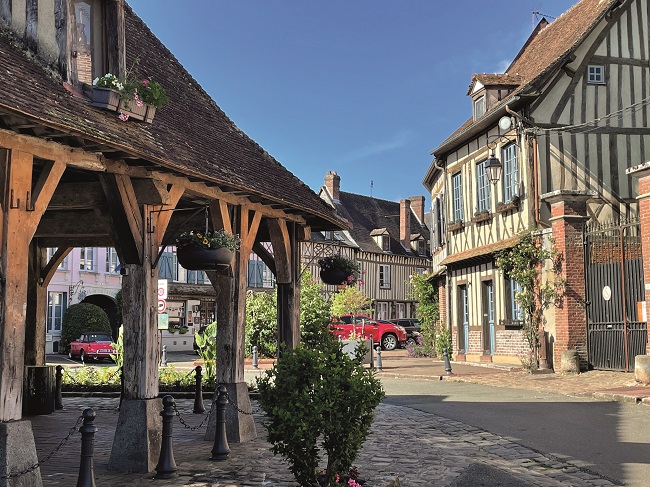
Quaint Lyons la Forêt © Gillian Thornton
Deep South
Two tranquil Regional Nature Parks cover a large part of southern Normandy. In the centre, the Normandie-Maine Parc Naturel Régional (PNR) includes Domfront with its ruined medieval castle, the floral spa town of Bagnoles-de-l’Orne, and the imposing Château de Carrouges. I stop off at Alençon, famous since the 17th century for its high-quality lace-making, and at Saint-Ceneri-le-Gérei, classified amongst France’s Plus Beaux Villages, before passing seamlessly into the Perche PNR. This area of forest, farms and small villages shamelessly tempts drivers to abandon the car and explore on foot, bike or – even better – four-legged horsepower.
As a lifelong rider, I jump at the chance to see the countryside from a carriage drawn by two beautiful Percheron heavy horses, a breed once used widely for agricultural work but now maintained only thanks to a band of enthusiasts. Ask at local tourist offices or at the delightful Maison du Parc beside the 15th-century Manoir de Courboyer in Nocé.
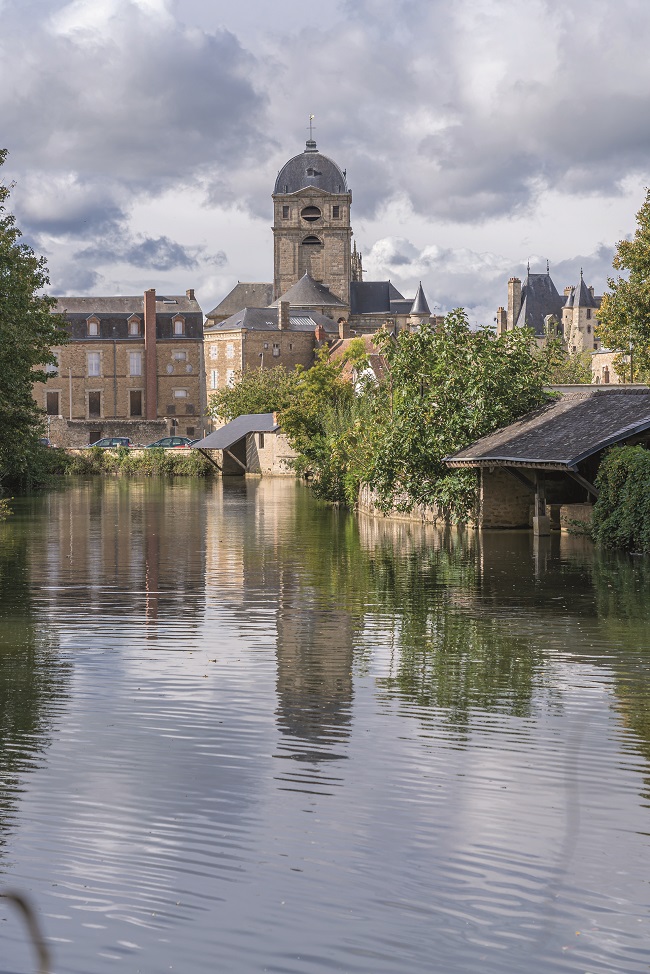
Alençon, France – 10 04 2020: Reflections of the Notre-Dame d’Alençon Basilica on the river
The former seat of the Counts of Perche, the market town of Mortagne-au-Perche was strongly fortified during the Hundred Years War against the English. Today the ramparts are mostly gone, but fine buildings still dot the streets: just follow the numbered panels to discover the stories behind the turrets, towers and hidden cloisters. And for a true taste of the town, be sure to try one of the many variations on black pudding, the local speciality.
The Perche PNR is a popular weekend destination for Parisians, so expect pretty tea rooms, craft shops and antiques dealers at villages such as Bellême and La Perrière, both justifiably labelled Petites Cités de Caractère by the Orne department.
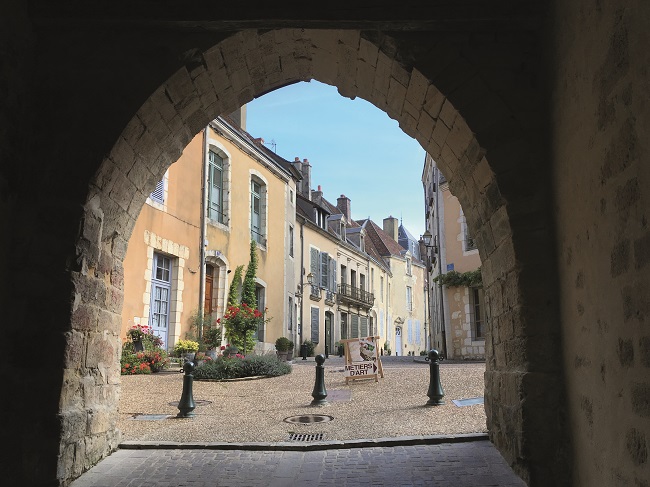
The village of Bellême in the Perche natural park © Gillian Thornton
Cheese and Cider Country
I indulge in a different kind of horse heaven as I head north through the Orne towards cheese and cider country. Le Haras du Pin stud farm – dubbed ‘the Versailles of the Horse’ – was built by order of Louis XIV and now hosts around 100 days of national and international events every year, as well as guided and self-guided visits.
At nearby Gacé, I drop in at Les Vergers de la Morinière where Astrid and Rudolph Hubert are the fifth generation of cider and calvados producers on the 60-hectare family farm that lies at the southernmost point of this famous Pays d’Auge cider region. And I’m really glad I left room in the boot for some liquid souvenirs!
My GPS is set for Camembert, home of some of France’s best-known cheeses, but first I make a small detour to Mont-Ormel, where a hilltop memorial and museum show how the Battle of Normandy unfolded in the days and weeks after the D-Day landings of June 1944. As the daughter of a D-Day veteran, I am humbled to discover how the conflict progressed inland.
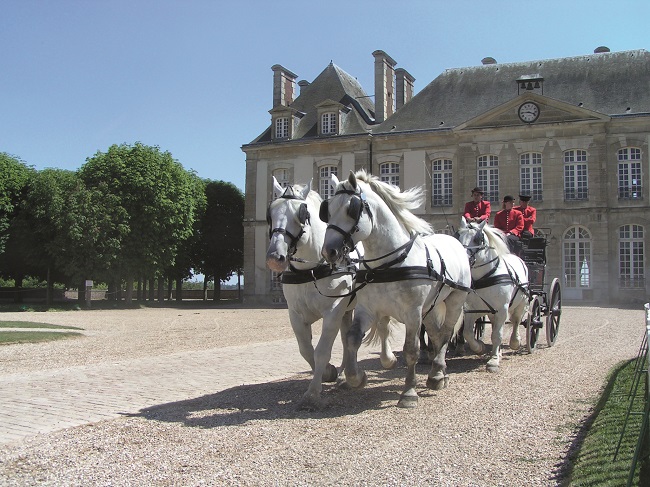
The Haras du Pin © CDT Orne
Then it’s on to the tiny hamlet with an international reputation. There are barely half a dozen houses in Camembert: the rest of the 200-or-so residents live at outlying farms and houses. A sign at the entrance to the village points to Normandy’s three other PDO cheese villages – Livarot, Pont-L’Evèque and Neufchâtel- en-Bray. But Camembert truly is the big cheese here, in every way: find out why (and have a taste) at the Maison du Camembert.
Normandy’s interior is deliciously undulating, but head west from Camembert through the heritage town of Falaise, birthplace of William the Conqueror, and you hit a unique area where the River Orne cuts through a granite massif to create the Suisse Normande. If canoeing or paragliding seem a tad too adventurous, take a gentle walk and then settle down with a picnic of local cheese and cider to watch the fun.

Pont l’Evêque cheese © shutterstock
Seine Valley
Of Normandy’s five departments, only Eure has no coastline, but it does boast one mighty river, which wiggles its way west from Paris in huge loops. Artists have always been attracted to the natural scenery and man-made architecture of the Seine Valley, but it was Claude Monet who put the Seine Valley firmly on the international art map. So I head next to Giverny on Normandy’s easternmost border with Île-de-France.
Monet moved here in 1883, half way through his long life, and set about creating his ideal garden, including that famous lily pond, the subject of so many large-scale works. Giverny attracts visitors from all over the globe and is a favourite with river cruise itineraries, so visit early or in low season for the most intimate experience. But if you love Monet, you won’t want to miss the dramatic splurges of seasonal colour that combine to create new Impressionist scenes for today’s garden visitors.
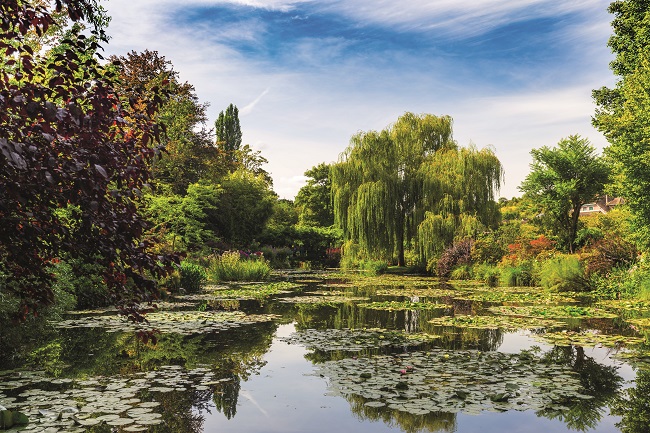
The nymphea pond in the garden of Claude Monet in Giverny © shutterstock
A short drive from Giverny, don your stout shoes to tackle the uneven paths to the hilltop ruins of Château Gaillard, Richard the Lionheart’s strategic riverside fortress outside Les Andelys. Then drive through the forest to Lyons-la-Forêt, a gorgeous mix of half-timbered and brick-built buildings around a triangular ‘square’ complete with wooden market hall.
Back by the Seine, I watch the river traffic over an apéro in the garden of Hostellerie Saint-Pierre. Ocean-going vessels can cruise 120km up river to Rouen, but the Seine is navigable far beyond Paris by commercial barges and river cruisers. Here, west of Rouen, the river meanders through the Boucles de la Seine Normande PNR in huge, sweeping loops (boucles) that offer drivers a chain of themed routes, first Abbeys, then Fruit, and finally Thatched Cottages, en route to Le Havre and the sea.

View of the Seine from Château Gaillard © Gillian Thornton
Rouen
No tour of inland Normandy would be complete without a stopover in Rouen, Normandy’s regional capital. The Radisson Blu Rouen Centre has its own underground car park on the edge of the historic centre, so I abandon the car to soak up this lovely city on foot. Many years on from my last visit, I find that Rouen is now very foot-friendly with a substantial pedestrianised area linking the major heritage sites and shopping area. Still in Monet’s footsteps, I head first to the cathedral to soak up that flamboyant sculpted façade, painted by the great man almost 30 times in a variety of different lights. Eleven versions were completed in a room over what is now the Tourist Office but was then a clothing shop.
The heart of Richard the Lionheart lies within Rouen Cathedral, while the rest of his remains are interred at Fontevraud Abbey with his Plantagenet parents, Eleanor of Aquitaine and Henry II of England. Don’t miss the modern architecture of the Joan of Arc Church in Old Market Square near the spot where she was martyred in 1431. I’m not a fan of the concrete exterior, but the medieval stained glass inside is stunning. I also recommend an hour on a multi- media journey through the excellent Joan of Arc Historial in the Archbishop’s Palace where Joan’s trial took place. Not far from Joan’s church, the iconic Great Clock spans a busy shopping street. Head inside the bell tower for a closer look but leave time for the outstanding Impressionist collection at the Fine Arts Museum, one of eight free city museums.

Rouen’s beautiful clock © Gillian Thornton
From Rouen, I take the scenic route southwest towards Caen and my return ferry from Ouistreham, stopping on the way to visit Le Bec-Hellouin, another stunning half-timbered village which grew up around a major abbey with some impressive alumni. In the 11th and 12th centuries, three of its abbots were appointed Archbishop of Canterbury, three became Bishop of Rochester, and others headed up abbeys across the UK, from Westminster to Chester.
Like so many places in inland Normandy, the abbey precincts are an unexpected delight – the very best kind of holiday surprise.
From France Today magazine
Lead photo credit : Saint-Céneri-le-Gérei in inland Normandy © shutterstock
Share to: Facebook Twitter LinkedIn Email
More in driving, driving in France, French road trip, Normany, road trip
Leave a reply
Your email address will not be published. Required fields are marked *




REPLY
REPLY